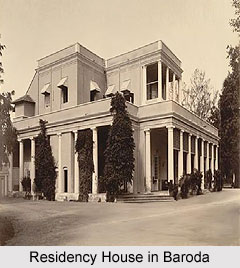 The Baroda Residency was one of the residencies or political offices of British Empire in India. These Residencies were primarily political offices, which were administered by a Resident of British India. The purpose of the residencies in British India was to manage the associations and alliances between the rulers of the princely states of India and the British Government of India. Thus the Baroda Residency supervised the relations between the Indian princely state of Baroda and the British administration between the period 1806 and 1930. The Baroda state was ruled and governed by the Gaekwad dynasty from its establishment in 1721.
The Baroda Residency was one of the residencies or political offices of British Empire in India. These Residencies were primarily political offices, which were administered by a Resident of British India. The purpose of the residencies in British India was to manage the associations and alliances between the rulers of the princely states of India and the British Government of India. Thus the Baroda Residency supervised the relations between the Indian princely state of Baroda and the British administration between the period 1806 and 1930. The Baroda state was ruled and governed by the Gaekwad dynasty from its establishment in 1721.
After the Second Anglo Maratha War during 1803 to 1805, the Gaekwads of Baroda developed their relation with the British and made peace. They entered a subsidiary alliance that accepted British suzerainty and control of the external affairs of the princely state. The ruler of Baroda was permitted to retain internal control and autonomy.
According the 1911 census of India, the princely state of Baroda had a total population of 2,032,798 people and the state covered a total area of 8,182 sq km. Baroda was amongst the wealthiest and largest princely states in India which existed alongside British dominated India and lucratively earned from the developing cotton industry as well as cultivation of wheat, rice and sugar. Thus, a British Resident, also known as political agent, was appointed to the state in the Baroda Residency as it was one of the major Indian princely states. The Resident did not deal with any other state.
During the 1930s, the Baroda Residency was merged with the princely states that were adjoining to the Bombay Presidency. It formed the Baroda, Western States and Gujarat Agency. The princely state of Baroda, which was the 3rd largest princely state during the British rule in India, was officially acceded to the Union of India on 1st May 1949. The autonomy and independence of the state ended when it acceded to the newly formed Dominon of India. Initially the princely state was combined with the Bombay state, but later on 1st May 1960, with the formation of the states of Maharashtra and Gujarat, Baroda was merged with Gujarat.



















